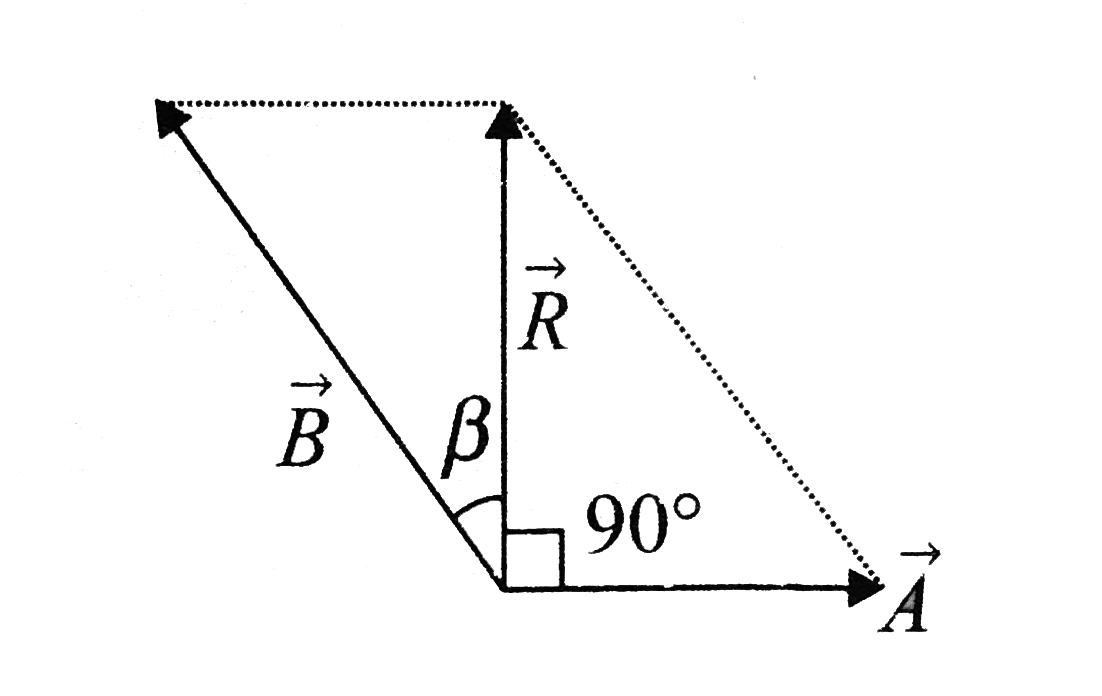The resultant of two vectors →P and →Q is →R. If the magnitude of →Q is doubled, the new resultant vector becomes perpendicular to →P. Then, the magnitude of →R is equal to
P+Q
P
P−Q
Q
The correct Answer is:D
To solve the problem, we need to analyze the situation step by step.
Step 1: Understand the vectors and their resultant
We have two vectors, →P and →Q, whose resultant is →R. The relationship can be expressed as:
→R=→P+→Q
Step 2: Doubling the magnitude of vector →Q
If the magnitude of →Q is doubled, we denote the new vector as 2→Q. The new resultant vector, which we will call →R1, can be expressed as:
→R1=→P+2→Q
Step 3: Condition of perpendicularity
According to the problem, the new resultant →R1 is perpendicular to →P. This means that the dot product of →R1 and →P is zero:
→R1⋅→P=0
Step 4: Express the dot product
Substituting →R1 into the dot product condition, we have:
(→P+2→Q)⋅→P=0
Expanding this gives:
→P⋅→P+2→Q⋅→P=0
Letting P=|→P| and Q=|→Q|, we can express this as:
P2+2Qcos(θ)=0
where θ is the angle between →P and →Q.
Step 5: Solve for Q
Rearranging the equation gives:
2Qcos(θ)=−P2
Thus,
Qcos(θ)=−P22
Step 6: Find the magnitude of the resultant →R
The magnitude of the resultant vector →R can be found using the formula:
R2=P2+Q2+2Qcos(θ)
Substituting 2Qcos(θ)=−P2 into the equation yields:
R2=P2+Q2−P2
This simplifies to:
R2=Q2
Taking the square root gives:
R=Q
Final Answer
The magnitude of →R is equal to the magnitude of →Q:
|→Q|
We have two vectors, →P and →Q, whose resultant is →R. The relationship can be expressed as:
→R=→P+→Q
If the magnitude of →Q is doubled, we denote the new vector as 2→Q. The new resultant vector, which we will call →R1, can be expressed as:
→R1=→P+2→Q
According to the problem, the new resultant →R1 is perpendicular to →P. This means that the dot product of →R1 and →P is zero:
→R1⋅→P=0
Substituting →R1 into the dot product condition, we have:
(→P+2→Q)⋅→P=0
Expanding this gives:
→P⋅→P+2→Q⋅→P=0
Letting P=|→P| and Q=|→Q|, we can express this as:
P2+2Qcos(θ)=0
where θ is the angle between →P and →Q.
Rearranging the equation gives:
2Qcos(θ)=−P2
Thus,
Qcos(θ)=−P22
The magnitude of the resultant vector →R can be found using the formula:
R2=P2+Q2+2Qcos(θ)
Substituting 2Qcos(θ)=−P2 into the equation yields:
R2=P2+Q2−P2
This simplifies to:
R2=Q2
Taking the square root gives:
R=Q
The magnitude of →R is equal to the magnitude of →Q:
|→Q|
Topper's Solved these Questions
- VECTORSBOOK - CENGAGE PHYSICSCHAPTER - VECTORSEXERCISE - Exercise Multiple Correct
5 Videos
- VECTORSBOOK - CENGAGE PHYSICSCHAPTER - VECTORSEXERCISE - Exercise Subjective
28 Videos
- TRAVELLING WAVESBOOK - CENGAGE PHYSICSCHAPTER - TRAVELLING WAVESEXERCISE - Integer
9 Videos
- WORK, POWER & ENERGYBOOK - CENGAGE PHYSICSCHAPTER - WORK, POWER & ENERGYEXERCISE - Archives (integer)
4 Videos
Similar Questions
Knowledge Check
The resultant of two vectors →P and →Q is →R. If →Q is doubled then the new resultant vector is perpendicular to →P. Then magnitude of →R is :-
AP2−Q22PQBQCPQDP+QP−QThe resultant →Pand→Q is perpendicular to →P. What is the angle between →Pand→Q?
Acos−1(P/Q)Bcos−1(−P/Q)Csin−1(P/Q)Dsin−1(−P/Q)if →P×→R=→Q×→R, then
A→P=→QB→P and →Q need not be equalCThere are infinite number of possibilities for →P (If →Q and →R are given ) which satisfy this relationship.D→p and →Q must be coplanar
The resultant of →Pand→Q is →R. If magnitude of →Q is doubled, magnitude of resultant is also doubled,when direction of →Q is reversed from initial condition then magnitude of resultant is again doubled, find P:Q:R.
View SolutionTwo vectors →a&→b have equal magnitudes of 10 m ,. Find the magnitude and direction of the resultant vector .
View SolutionTwo vectors →P and →Q are added, the magnitude of resultant is 15 units. If →Q is reversed and added to →P resultant has a magnitude √113 units. The resultant of →P and a vector perpendicular →P and equal in magnitude to→Q has a magnitude
View SolutionThe maximum value of the magnitude of the resultant of two vectors →Pand→Q is 24 units and the minimum value of the magnitude of their resultant is 4 units. What is the ratio of the magnitudes of the vectors →Pand→Q ?
View SolutionThe resultant of two vectors →A and →B is perpendicular to the vector →A and its magnitudes is equal to half of the magnitudes of vector →B (figure). The angle between →A and →B is

View Solution
